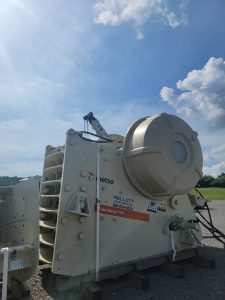Gems of Advice from Brandon Godman, Sales Engineer at Marion Machine Spotlight On: Jaw Crushers!

Written by Brandon Godman, Sales Engineer at Marion Machine
The Jaw Crusher is the primary crusher at most quarries… and that’s why it’s so important that you get to know this crusher inside and out- better than you even know yourself! To help you with this, I have compiled a list of preventative steps that I believe are imperative if you are to avoid the dreaded “downtime”. Most Operators do not like to pause their equipment to assess for problems, so they tend ignore tell-tale signs and move on… big mistake! Operators, this one’s for you!

- Perform a pre-shift inspection – it’s as simple as a walk around the equipment to look at all its components before you fire it up.
- Look at the dump bridge (check for hazards to tires as well as any other issues)
- Look at the feed hopper (make sure there is material in the feeder before that first truck gets dumped in)
- Look at your Lube system.
- If you have an auto greaser system- ensure the grease reservoir is full and ready to run
- If you have an oil system- start the system and ensure you have flow and pressure before you fire up the crusher
- Check your rock breaker oil level (if equipped with one)
- Check the water flow of dust suppression system.
- Once the pre shift inspection is complete- it is time to fire the beast up! Start up the jaw and let it run for a little bit: ambient air temps and the age of machine dictate how long it may need to run prior to being put under a load. During startup pay special attention to the starting amp draw. This can be indicative of a possible bearing issue, or maybe even a motor issue such as “dragging”.
- At a set time – well into the shift (I personally chose right before lunch time – 12:00) you need to check amps while the jaw is running empty – aka “no load amps” as well as bearing temperatures (I used an infrared temperature gun). Once checked, document the results in a log. This will help you keep an eye on bearing life and potential issues. It’s important to be looking for a day-to-day change (this is why documenting the temps and amps every day is crucial). You are also looking for a difference between the two sides. A side-to-side difference can be your “red alarm”. If this happens, it should be further investigated immediately.
- At the end of the shift measure and record your coast down time. This is accomplished by starting a stopwatch immediately as the jaw is shut down- measure the amount of time it takes for the jaw to come to rest with the counterweights at their lowest point. This should also be recorded daily. This specific measurement is to look for gains or losses during the coast down time from day to day. If your coast down time is getting longer (i.e., 2:25 becomes 2:45 then 3:00) this can mean your bearings are gaining clearance and could be an indicator of impending bearing failure. If you are losing time (i.e., 2:25 becomes 2:15, then 1:45) this can be an indicator of bearing issues or may even indicate shaft alignment issues.
- Once the Jaw is “locked out and tagged out” it is then time to inspect the machine – This includes going under the jaw and taking a closer look at it in detail.
- Look at the wear materials/liners to ensure the base is protected against premature wear.
- Check your toggle block, toggle seat, and toggle plate for wear and signs of damage or cracking.
- Check your tension rods and springs for signs of damage and wear.
- Check for any signs of damage or wear the base bolts.
- Check your wedge bolts.
- Check cheek plate bolts.
- Check for anything that might “stand out” as different or questionable.
- If any areas of concern are found address them ASAP – do not wait! What could be a simple fix today can end up as a major problem in just a few days.
- Don’t neglect the other parts of the primary!
- Check your feeder from the bottom side- look at your spring clusters for material buildup (it is important to wash it out and keep the spring areas clean)
- Check the rock box to hopper area for signs of contact & movement.
- Check your feeders for loose feeder bottom bolts – or any other signs of a problem.
- Check your hopper wings from the underside to look for signs of cracking or problems in the structure itself.
- Check your primary conveyor – look at the pulleys, rollers, guards, and anything else that could cause the machine not to be ready the next time it’s needed to operate.
- Watch, feel, and listen all day! There are always signs of impending problems if we pay close attention and look hard enough! I had the privilege of working with some true “operators”. I got to learn that they could feel, see, and hear a problem way before it got to the point of being a catastrophe. I learned that a simple “tinging” sound can actually be a loose cheek plate bolt to someone who is paying close attention their equipment. It doesn’t take long to egg out a bolt hole and end up with a cheek plate that will never be tight again in that area (unless of course you send the base to me and let me weld them back up as well as weld and machine the cheek plate area). Always ere on the side of caution… and if you ever think there may be an issue, stop your equipment and check!

When I was an Operator, I knew the routine checks of my equipment were important. It wasn’t until I worked at Marion Machine, that I recognized the major problems I had unknowingly been avoiding by taking the time to really know my equipment and recording my findings so I could know my machine “inside and out”.
The true “moral of the story” is to set a routine that you do every day, know your equipment as thoroughly as you can, and take the time to stop production to check for possible issues if you feel things are not right. Just a few minutes of inspection and troubleshooting can avoid hours, days, or even weeks of downtime. Good luck and have fun making little ones out of big ones!
Written by: Brandon Godman
Follow us on LinkedIn, Facebook, Twitter, Instagram, and check out our Website!
Christopher Joyce Vulcan Materials of Winston-Salem, NC
Our Metso HP 800 Mainframe had a loose shaft and we re-fit the shaft back to OEM specs with a 2-week-turnaround to get a 3.5-million-ton-plant back up and running.